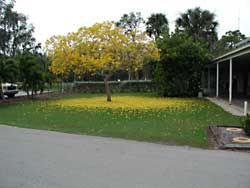|
Paspalum
is certainly the newest golf and sports turfgrass to hit the industry
in many years. Though it is not difficult to cultivate
paspalum for the well trained Turf Manager, its maintenance guidelines
are different from other turfgrass species-especially Bermudagrass.
And then, if introduced into an environment that
Bermudagrass could not, or should not be grown in, it becomes a
little more challenging, so different avenues of construction techniques
and turfgrass cultivation must be implemented. |

Spring at Alden Pines with a Tab Tree shedding blooms
on top of SeaWay® paspalum |
Paspalums
many favorable attributes makes it much tougher than our presently
well known turfgrasses, but it does have its limitations. Just because
Seashore paspalum is tough, it does not mean that it can be installed
in a sports turf environment with no attention paid to the same
important factors that would be considered for other turfgrasses.
And again, if we are contemplating using paspalum in a challenging
environment, then we will need to pay very close attention to its
installation environment and the golf course construction techniques.
Anytime we use the term "challenged environment",
or "non Bermudagrass environment", etc., we are describing
any of the following; water other than "fresh" which would
include: effluent, brackish, or any water with any amount of salinity
levels above 500 PPM, TDS. Other challenged sites, regardless of
the quality of water available could include low rainfall regions
(arid sites), high rainfall and cloudy regions, areas prone to salt
spray, tropical storm flooding from either fresh water or salt water,
hurricanes, or sites that have salt affected soils, high or low
pH soils, and most any other "harsh" turfgrass environment.
Let's take for example a site that has high pH soil,
high pH water, low salinity water in the 800-1,500 PPM range and
times of low rainfall and very high ET rates. I have experience
in a site of this type and we may all consider it a potential disaster
(or very high cost) to grow a Bermudagrass variety in such a site.
So, we decide to use paspalum, but that cannot be the only concluding
factor to consider. Paspalum will survive in such a site, but of
course we want it to flourish and without strict design and construction
protocols, even paspalum will fail, or give a less than outstanding
playing surface.
This is where the experience of a well seasoned paspalum
consultant can make a big difference. There is plenty of education
to rely on, but experience and common sense will play the biggest
role in the end. |

